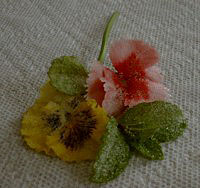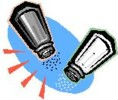Make the most of culinary herbs and spices.
Other articles you might enjoy:
2. An Herb Gardener's Diary--Part Two
5. A Book Review: The Herbfarm Cookbook
Here's one that's full of our favorite recipes because we wrote the book! It is also full of information, helpful hints and ideas for using herbs and spices in your kitchen.
Take Time to Stop and Eat the Flowers
by Sandra Bowens
Here are the answers to all of your questions arranged season by season. Fully illustrated, this growing guide covers 64 different herbs.


I have long had a vision of creamy lavender truffles coated in white chocolate and garnished with candied Johnny-jump-ups.
The first time my friend and I tried to make candied flowers, things didn't work out so well. Just dipping the flower into egg white and then piling on sugar created a big mess. The sugar clumped on the petals or melted to a paste. Many of the recipes in my craft and cookbooks for crystallizing flowers called for superfine sugar. Thinking this must be key, I ordered that from the King Arthur catalog. I bought a watercolor paintbrush. By the time I had gotten around to collecting all the supplies, the flowers were gone.
Trial and Error
Fast forward to the next season when I had pots overflowing with pansies and Johnny-jump-ups. This time I would approach the process as a scientific experiment, I decided. I set up two stations: One with different combinations of egg washes and the other with different grinds of sugar.
One egg wash that I thought might be a brilliant idea was to use Egg Beaters, the commercial egg substitute. I thought the silkiness of this product would "paint" on better. Although that was true, both the granulated and the superfine sugars still melted or clumped. Probably because of the other ingredients added to the whites.
Next I turned to real egg whites at room temperature. For one batch I added a couple of teaspoons of water and to the other I added nothing. Still, the sugar did not adhere to the flowers as I had envisioned.
Over at the sugar station, the superfine sugar did not perform as I had hoped. It melted and caked. The granulated sugar seemed to be what I was looking for.
Eureka!
Luckily I had plenty of Johnny-jump-ups because I just kept trying different combinations and methods. At last, I lit upon the method that worked best for me.
Using just the egg whites, I brushed on the thinnest coating that I could onto both sides and then paused for thirty seconds. After that brief drying time, I gently sprinkled on the regular granulated sugar just until it stuck. By giving the flower a light dusting rather than blanketing it in the sugar, the color still shone through and the individual grains of sugar took on a sparkle.
To help with that gentle sprinkle of sugar I used a small stainless steel tea strainer with a handle. Any sieve with holes large enough for granulated sugar to fall though would probably work.
Another key to a lovely appearance was to take care that the egg white did not pool into the base of the flower where all the petals come together. I found that it worked fine to brush only the petals, the center took care of itself.
After the flowers are coated nicely, dry them on a sheet of parchment paper. When they are completely dry, store in an airtight container if you are not using them right away.
Safety First
The most important factor in making candied flowers is that you must know how they were grown. You should not eat anything that has been sprayed with chemicals such as pesticides or toxic fertilizers. That is why you would never want to ingest flowers from a florist or commercial grower, you just don't know.
The solution, of course, is to grow your own plants. Use only safe pesticides if you must or look into homemade solutions like those that are vinegar-based.
Equally important is the fact that not all flowers are edible. You must be absolutely certain that a flower is safe to eat before you use it as a garnish of any kind. Even with edible flowers there are parts of them that don't taste good so you should know that as well. Check out The Edible Flower Garden (Edible Garden Series) by Rosalind Creasy for more information. See link at right.
Do not assume that just because one plant is similar to another that they are the same.
I nearly made this mistake last year with lilies. Having read that day lilies are excellent for cooking, I got excited because I thought my Oriental lilies would be so beautiful in salads or as a garnish. Soon I learned that Oriental lilies are not day lilies and should not be ingested.
Yet another safety consideration is the raw egg white. The word from food standard officials is that raw eggs should not be consumed under any circumstances. Individually, it comes down to a matter of personal choice. I do not worry about it in the case of candied flowers for myself but I would not serve these to children, the elderly, a pregnant woman or someone who is ill.
A safe alternative for this dilemma is to use pasteurized egg whites. Just make sure there is nothing added such as water or preservatives. As we saw above, the commercially available egg substitutes did not work for making candied flowers.
Forget the Flowers
Making sugared flowers is a delicate process. Intricate petals can make it a bit frustrating at times. Not so with herbs!
The most enjoyment I found from this whole process was with the sugared herbs. Glittering green leaves of mint and lemon verbena were quite pretty. They tasted great and were easy to do. I even did entire sprigs that would make a delightful garnish for desserts.
The sugared spearmint was like an after dinner mint and the lemon verbena tasted just like a lemon drop. You could try any of the different mint varieties as well as pineapple sage, scented geraniums, lemon balm, lavender…I wonder if tarragon would be good?
Helpful Hints
Use fresh blooms that are freshly cut. Leave a good bit of stem for ease in handling. Inspect your harvest carefully, I nearly candied a snail.
Try starting with dianthus, or pinks, to gain confidence. They seem to take the coating the best of all those I tried and are also very pretty.
Do this on a dry day, high humidity will increase the drying time giving your sugar opportunity to become soggy.
Use as little sugar as possible. Your candies will dry more quickly and more of the color from the flowers will show through.
Remember, all herb flowers are edible.
Separate the eggs while still cold but then let them come to room temperature for easier "painting."
Use a good quality, soft paintbrush.
Store in an airtight container or the flowers will shrink as they dry up.
Next Step: The Truffles
Now that I have the garnish down, my thoughts turn back to the truffles. Watch for part two.
Edible Flower Links
A comprehensive list of flowers and their flavors from North Carolina State University.
Find tons of information complete with pictures about edible flowers.
Tips from the Garden Helper for growing and using edible flowers.
This site's readers love this book. Filled with glorious photographs, it will give you new ideas for a lovely flower garden that tastes good too.
Use flowering herbs to punch up landscape design. This guide covers 700 plants from 80 families.





